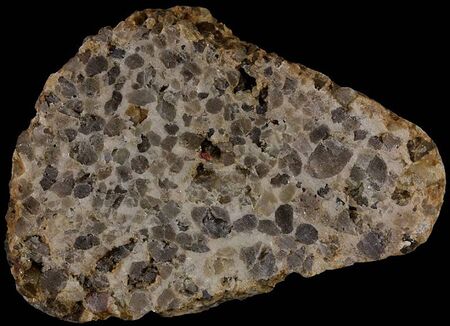Conglomerates
Conglomerate is a clastic sedimentary rock that contains large rounded clasts with a diameter from 2 mm to 63 mm. These clasts are poorly organized and present in a finer matrix. The lithology of the clasts and the matrix can be different from each other, but there is a possibility they are the same. Conglomerates mainly are formed in river areas. This rock type differs from breccia with its rounded clasts.
Origin
Sediments which are taken by a strong water current change shape because of the high energy level of the current. The shape of long and fast transported sediments becomes round and more flat shaped. The environment in which conglomerates are created must be a swiftly flowing stream or a beach with strong waves. To form a conglomerate, there must also be a source of large-size sediment particles somewhere up current. The rounded shape of the clasts reveals that they were tumbled for some distance by running water or moving waves. These conditions are found in streams and standing water bodies in many parts of the Earth. Conglomerates often begin when a sediment consisting mainly of pebble- and cobble-size clasts is being deposited. The finer-size sand and clay, which fill the spaces between the larger clasts, is often deposited later on top of the large clasts and then sifts down between them to fill the interstitial spaces. After compaction, the deposition of a chemical cement then binds the sediment into a rock.[1]
References
Conglomerate

| Group | Clastic sedimentary rock |
| Texture | Coarse-grained |
| Clasts | 2 mm - 63 mm |
| Hardness | Varying much |
| Color | Varying much |
| Minerals | All kind of rock minerals |
| Touch | Rough but smoothed clasts |
| Image | Conglomerate image |
Contents